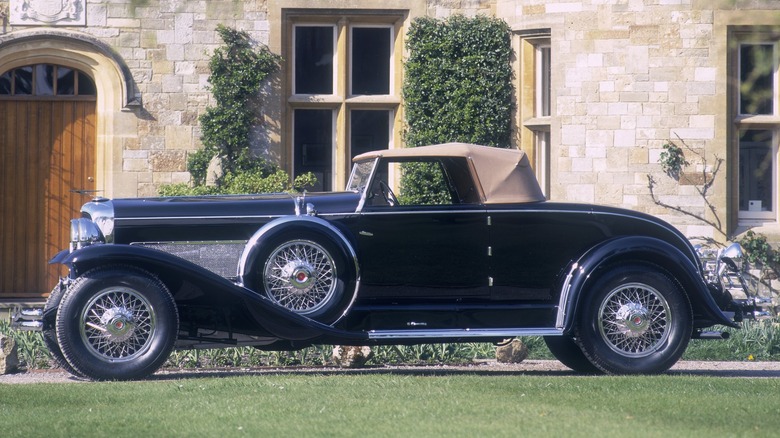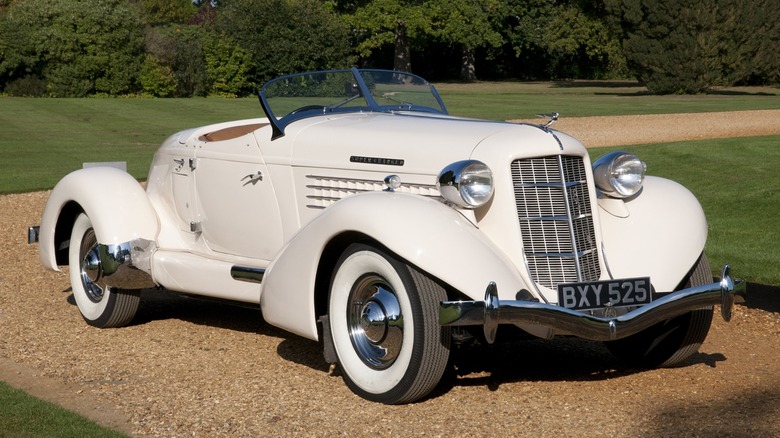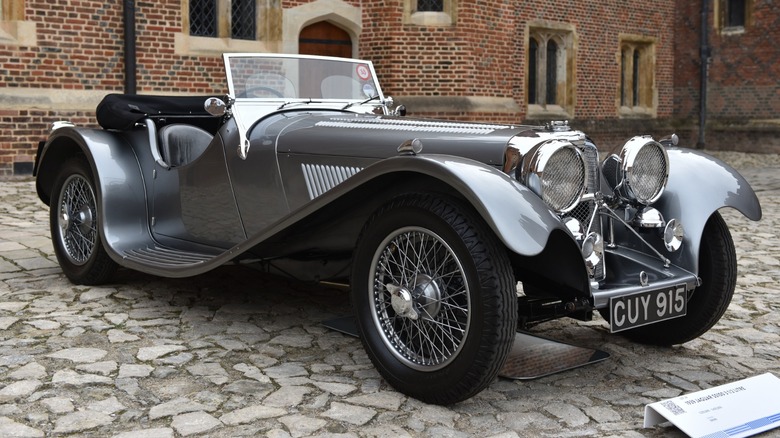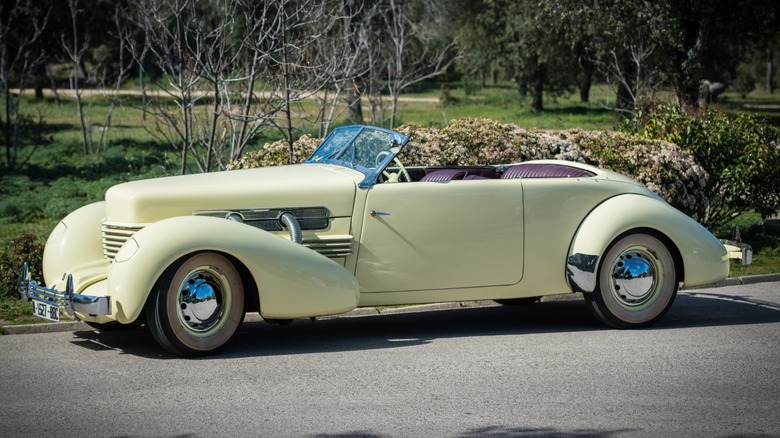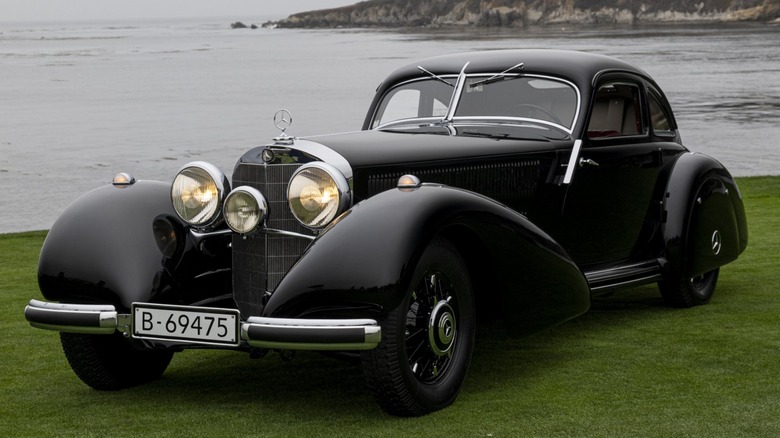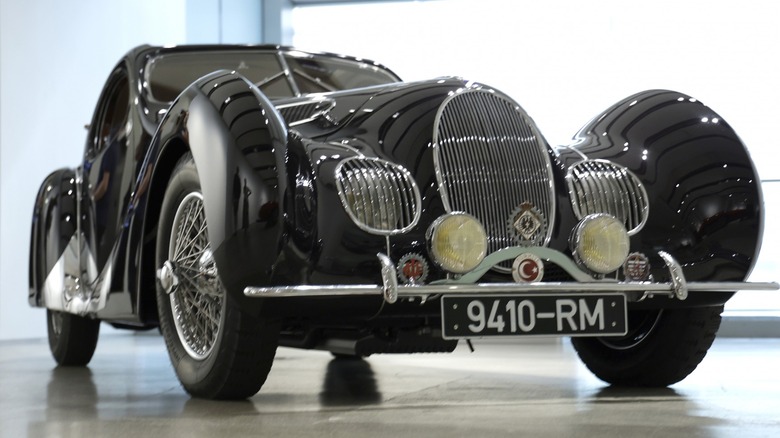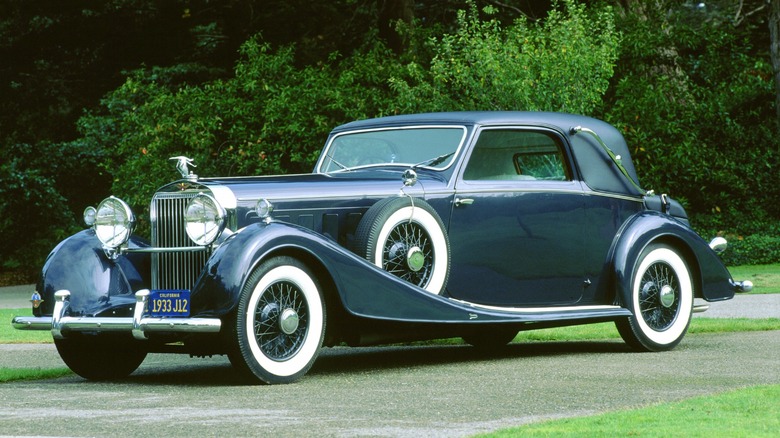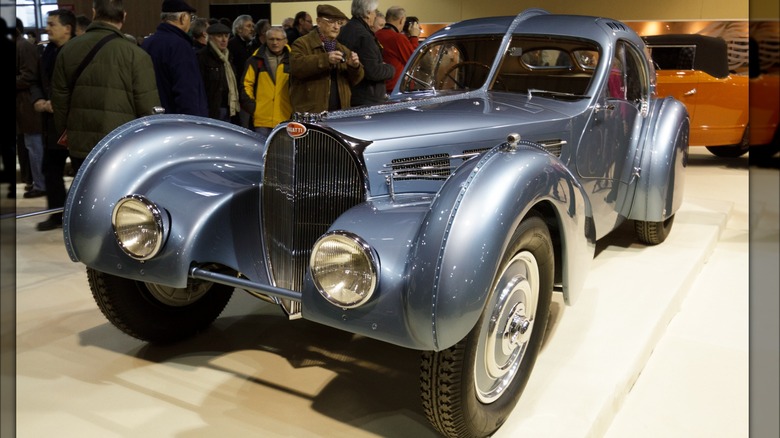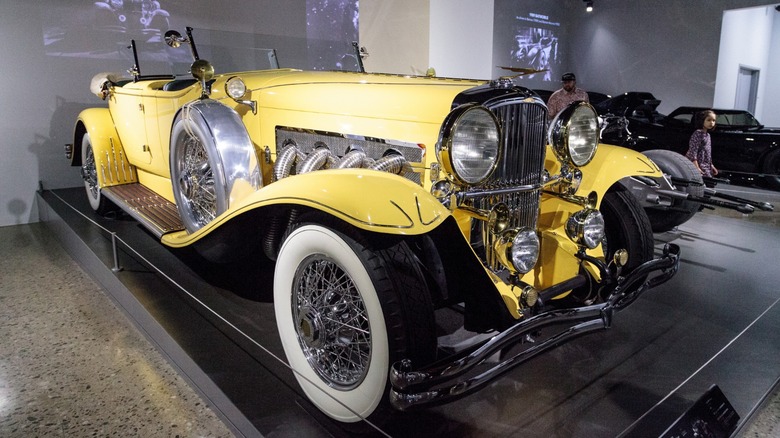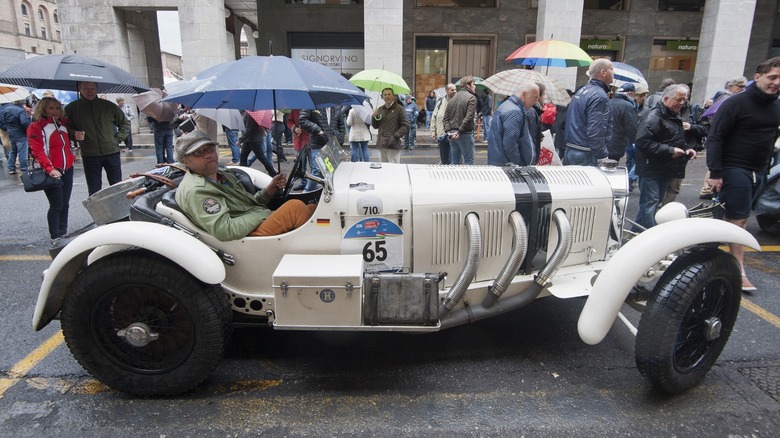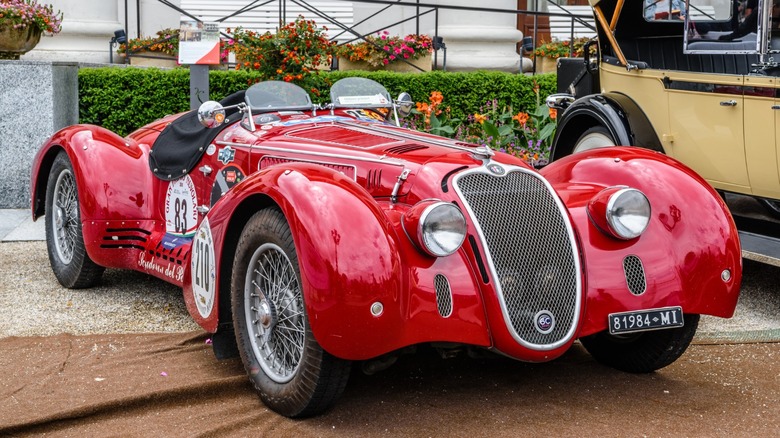10 Of The Fastest Pre-War Cars, Ranked
During the Brass Era, before World War I, automakers were just trying to figure out how to make things go. However, by the time the war passed and regular life was able to resume, engineers got to work creating cars for the masses as well as cars with pursuits of speed in mind. This led to friendly competition among automakers, with each of them trying to outdo each other and bring to market the best and fastest models for sale. The speediest among them came with significant price tags, meaning only the well-heeled could experience the sensation on public roads.
The first speed limits in the U.S. were set to speeds of around 12 to 15 mph. Despite these legally imposed limits, manufacturers sought to continue building the best cars possible, including making them ever more powerful from the continuing improvements in engineering that occurred throughout the era. Some of the cars of the time exhibit innovative and clever engineering, and many models from this era today are highly valuable machines worthy of museum-level preservation. Sadly, civil order devolved into chaos with the onset of WWII, and auto production for consumers ended around the globe, signaling the end of an era. With a look at cars released before the outset of hostilities, here are 10 of the fastest pre-war cars listed from fast to fastest.
Auburn Speedster 851 :100.8 mph
One of America's earliest luxury automakers was Auburn. It was founded at the turn of the century and produced its first automobile in 1903. Difficulties plagued the company early on as so many companies entered the market made it difficult to stand out. This led to ownership changes over the years, eventually being a part of a group with Duesenberg and Cord automobiles.
The Auburn models of the '30s are some of the most elegant and attractive from the company. Sadly, Auburn would not survive the Depression, and its last model year was 1936. But before then, it released the 851 Speedster, a sleek and curvy open-top two-seater powered by a straight-8 engine with supercharger putting out 150 hp. A unique detail of these cars is the application of a plaque on the dashboard certifying that "this Auburn Automobile has been driven 100.8 miles per house before shipment." This gave credence to the car's abilities and speed capabilities on each and every model directly from the factory.
Although Auburn ceased production shortly before WWII, its cars remain valuable today. A replica of a Speedtail even shows up in the classic film "Indiana Jones and the Temple of Doom." The remnants of the company changed hands until they ended up in Broken Arrow, Oklahoma, where the cars are not only serviced and restored but reproduction models are also manufactured in limited numbers.
SS Jaguar 100: 101 mph
The car company known as Jaguar was first called the Swallow Sidecar Company, and it produced cars under the SS name, including a sports car in the late '30s called the SS Jaguar 100. WWII made the SS moniker unsavory, so all cars after the war would become simply Jaguars. But before the war, the SS Jaguar 100 was the fastest model from the company, and one of the fastest of its day. As the SS company only began making cars around 1930, having a highly competitive model within a decade is an impressive feat.
The Jaguar 100 is typical of English sports cars of the period. It's small and low to the ground, with a tall grille and detached fenders. This makes it lightweight, which allows its 3.5 liter sitting under the long and slender bonnet to push the little car forward at a sprightly pace. Dual SU carburetors breathed 125 hp into the engine and the short wheelbase gave it precision handling. Autocar magazine tested the Jaguar 100, pushing it up to 101 mph with a zero to 60 time of 10.4 seconds, impressive performance at the time. Production ran from 1936 to 1940, and wartime production halted all passenger car manufacturing until 1946, when Jaguar Cars, Ltd. was officially born.
Cord 812 S/C Sportsman: 102 mph
E.L. Cord established an American auto company holding Auburn and Duesenberg in its portfolio of vehicles. Although he already had two exclusive marques under his control, Cord chose to add one bearing his name and introduced a highly innovative model in 1929 called the Cord L-29, which, as most may recall, was not the most fortuitous time in American history for big business. Despite launching a car just before the start of the Great Depression, Cord survived, at least, for a time.
The L-29 introduced Americans to front-wheel-drive, and that continued into later models, including the 812. Additionally, the 810 introduced the world to one of the most loved car features ever, the pop-up headlight. Innovation was a hallmark of the Cord 810/812 and the forward-thinking elements include the wrap-around front grille, rear-hinged hood, variable speed wipers, hidden door hinges, and a concealed fuel filler cap. Problems with brakes overheating led engineers to drill a series of holes in the wheel, which solved the issue and inadvertently created wheels with a striking appearance. Inside the car, drivers were greeted by a dashboard that looked more like that of an airplane, with full instrumentation complemented by a radio, a feature not standard in cars for many years after.
Also, the Cord was placed below the Duesenberg in price, but it was still a very expensive car. For the money spent on one, the 170 hp supercharged V8 propelled an 812S to a top speed of 102.3 mph, making it one of the fastest cars produced in its day.
Mercedes-Benz 540K: 110 mph
Germany's Mercedes-Benz is known today for making the finest luxury automobiles in the world, and that has been true throughout its entire existence. Even in the dark days of the Depression, Mercedes created and built some amazing cars, although they were only for the wealthiest of people. Expensive back then and worth an obscene amount of money today is the Mercedes-Benz 540K. That this car is fast among its contemporaries may appear to be its most important attribute, but its performance is easily overshadowed by the utter beauty of its styling. To say it is a work of art may be selling it short. But encased in its majestic beauty is another work of art in terms of engineering.
The K designation in its name stands for "kompressor," which is the German term for supercharger. The 540K is powered by a straight-8 with forced induction by way of a supercharger, technology pioneered by the automaker. This was also an exceedingly expensive car with custom coachwork fitted to the frame, built for sale to the most exclusive buyers in the world at the time and owned by princes and kings of the day, along with a particularly notorious German chancellor in power when it was built.
Regardless of its former despotic owners, the 540K performed extremely well. Its 5.4-liter engine produced 180 horsepower and an even more impressive 318 ft-lb of torque. Reports of its top speed hit 110 mph. Considering that well-preserved concours condition examples of a 540K can sell for more than $10 million today, we are unlikely to see the top speed of any of them tested any time soon.
Talbot-Lago T150C SS: 115 mph
In the early years of the automotive industry, French carmakers played pivotal roles. And while they were responsible for many groundbreaking inventions that contributed to the development of the automobile, they also created some fabulously lavish and beautiful automobiles. One such marque that is far from a household name, yet synonymous with French luxury, is Talbot-Lago.
Automobile Talbot nearly found itself in bankruptcy, only to be rescued by an Italian named Antonio Lago, leading to the Talbot-Lago models. It used clever engineering to find ways to exceed others and released a 6-cylinder engine that utilized a cylinder head with a crossflow (intake and exhaust manifolds are on opposite sides of the engine) design and hemispherical combustion chambers.
One of the most notable Talbot-Lago models from before WWII disrupted production is the T150C SS. Its inline-6 engine is 4.0 liters of displacement and produces 140 horsepower with natural aspiration. Although other engines were larger, the T150C SS was built with lightweight materials and used this to its advantage in accelerating quickly, achieving a top speed of 115 mph. Furthermore, its slippery contour allowed it to cut through the air while turning heads on the road. Talbot-Lago cars are extremely valuable today, often being chosen among the most beautiful cars ever made. RM Sotheby's sold one in 2022 for $7,265,000.
Hispano-Suiza J12: 115 mph
Hispano-Suiza is not generally a well-known automaker of the pre-war period. Those who owned one in the day paid significant sums for their cars as they were the most opulent and over-engineered vehicles on the roads. Hispano-Suiza had much experience building engines and many of them were found in the aircraft that fought during WWI, particularly the venerated SPAD. The automotive venture began in 1904, but by the 1930s, Hispano-Suiza cars were the pinnacle of luxury design and engineering.
The thing to know about a Hispano-Suiza J12 of the 1930s is just how imposing the car is. Its engine is a 9.4-liter V12 with overhead valves, making the engine bay enormous.. It uses dual water pumps, dual magnetos, and 2 spark plugs per cylinder. Power output was 250 hp with an abundance of torque from the massive engine. Unlike other fast cars of the period, which were sports cars or even high-end roadsters, the J12 is a luxury car with unmatched levels of craftsmanship. The precision engineering found in aircraft manufacturing is found throughout a J12 with everything built to the highest standard. Despite being a large luxury car, 9.4-liters of V12 made it possible to attain 115 mph, an extreme speed for any car of the period.
Bugatti Type 57SC Atlantic: 125 mph
Bugatti represents the fastest and most extravagant name in cars today. But this has long been a part of the brand's heritage, as its founder, Ettore Bugatti, worked tirelessly to create the most beautiful cars in the world featuring the best engineering possible in his day, just like the Veyron and Chiron of the modern day.
Before World War II, Ettore's son Jean, produced a series of cars equipped with the 3.3-liter Bugatti straight-8 engine and covered with perhaps the most elegant, shapely, and beautiful coachwork ever created. The Type 57SC Atlantic is a svelte coupe with a long hood covering the powerful engine with a body terminating in a teardrop shape at the rear bumper. There were four Type 57SC Atlantic cars built, of which three are accounted for today. The fourth one is lost to history, reportedly sent on a train for hiding but never making it to its final destination.
Of the three remaining cars, one was wrecked and rebuilt using some original parts and some reproduction pieces. That leaves just two original surviving examples, one of which is owned by renowned fashion designer Ralph Lauren. These were exclusive cars in the day and are exceedingly rare and valuable now. Furthermore, the supercharged engines are capable of pushing out 210 hp and hitting a top speed up to 125 mph. Should one come up for sale now, it is estimated that the selling price would exceed $100 million.
Duesenberg SSJ: 135 mph
In American automotive history, no name is more highly revered than Duesenberg. The cars made by this company were, at the time, the most extravagant vehicles made and were also the height of luxury on wheels. Duesenberg history is rather short, only lasting from 1920 to 1937, but had a significant impact on early American auto history. Additionally, when the Duesenberg brothers that founded the company were not building lavish passenger cars, they were building championship race cars.
Duesenberg engines were among the best in the world, and the cars that housed them were also among the most powerful models at the time. The Model J was the last model produced by the company. It came with a 420 cubic inch straight-8 engine with 32 valves and dual overhead camshafts. This was highly advanced and sophisticated for the time but would have been improved with the addition of a supercharger, which changed the designation of the car to a Model SJ. Power output for a supercharged Duesenberg is 265 hp, which is well above what any other car produced at the time, especially when considering the flathead Ford V8 output was about 65.
Duesenberg built two SSJ models, which were 7.0-liter supercharged and short wheelbase versions. These cars went to two famous actors, Clark Gable and Gary Cooper. Power output on these had been boosted up to an incredible 400 hp and were the fastest and most powerful passenger cars on the planet at the time. Top speed in a Duesenberg powered by the same engine reached 135 mph at the Bonneville Salt Flats in 1935.
Mercedes-Benz SSKL: 146 mph
Ferdinand Porsche is renowned for being the father of what would become the Porsche automobile company. He was a designer for other firms before then, with famous works including the design of the original Volkswagen Type 1, or Beetle. He also created designs for Mercedes-Benz in the pre-war period, and one of his most vaunted creations is the Mercedes-Benz SSK, built from 1928 to 1932.
SSK stands for Super Sports Kurs, German for Super Sports Short. It was a truncated version of the popular S roadster but fitted with a huge 7.1-liter straight-8 engine. These cars were bespoke creations built to order and could come with engine output of 200 to 300 hp, depending on the customer's order. The most powerful version is the SSKL (the L is for "leicht," German for light) that came with the overhead-valve 7.1-liter engine fed by a Roots supercharger, which was engaged by a clutch as engine speed increased. According to the Mercedes-Benz archive, top speed for this car is 146 mph, which is fast for a modern roadster but was unthinkable in 1933.
The SSKL was built as a competition car that could be ordered by the public, although never officially offered with the rest of the lineup of vehicles. Only a few were built, but some did race and win on the track. Today, SSK and especially SSKL Mercedes are extraordinarily valuable. They rarely come up for sale, but the winning bid for one at Bonham's in 2003 was $5,416,450 and the value has surely at least doubled since then.
Alfa Romeo 8C 2900B: 149.1 mph
Racing has always been integral for automaker Alfa Romeo. The company has won many checkered flags and was dominant in the period before WWII. One of its best racers, Enzo Ferrari, went on to build a company making the fastest cars on the planet. But in the 1930s, Alfa was the brand to beat. And the car to beat was the Alfa Romeo 8C 2900B.
Similar to the modern Ferrari Enzo or Porsche 959, the 8C was a road car built for a road racing course. It is powered by an Alfa straight-8 with dual overhead cams and dual superchargers to rev output up to 180 hp. The 8C was also produced for several years and came in one of several different body styles, produced by a coachbuilder, such as Carrozzeria Touring. Touring built the 8C 2900 MM for the Mille Miglia race, which was powered by a straight-8 making 225 hp and had a top speed of just over 142 mph.
Touring also worked extensively with aerodynamic principles at the time, learning how to decrease drag to increase speed and acceleration, resulting in the creation of the 8C 2900B LeMans. This model employed several raked exterior surfaces and sloped lines throughout the bodywork to make the car as slippery as possible. While official records available today are a bit inconsistent, several sources point to the fact that this car approached very near the 150 mph mark, a feat that remained impressive for cars all the way to the turn of the millennium.
